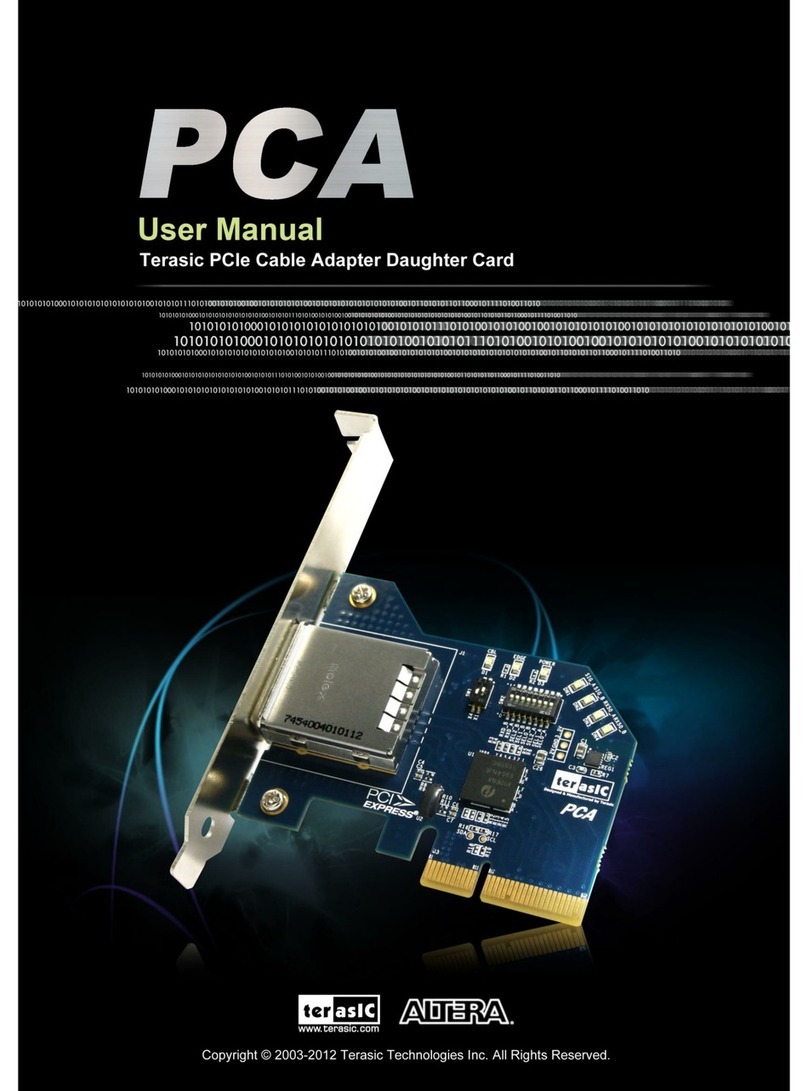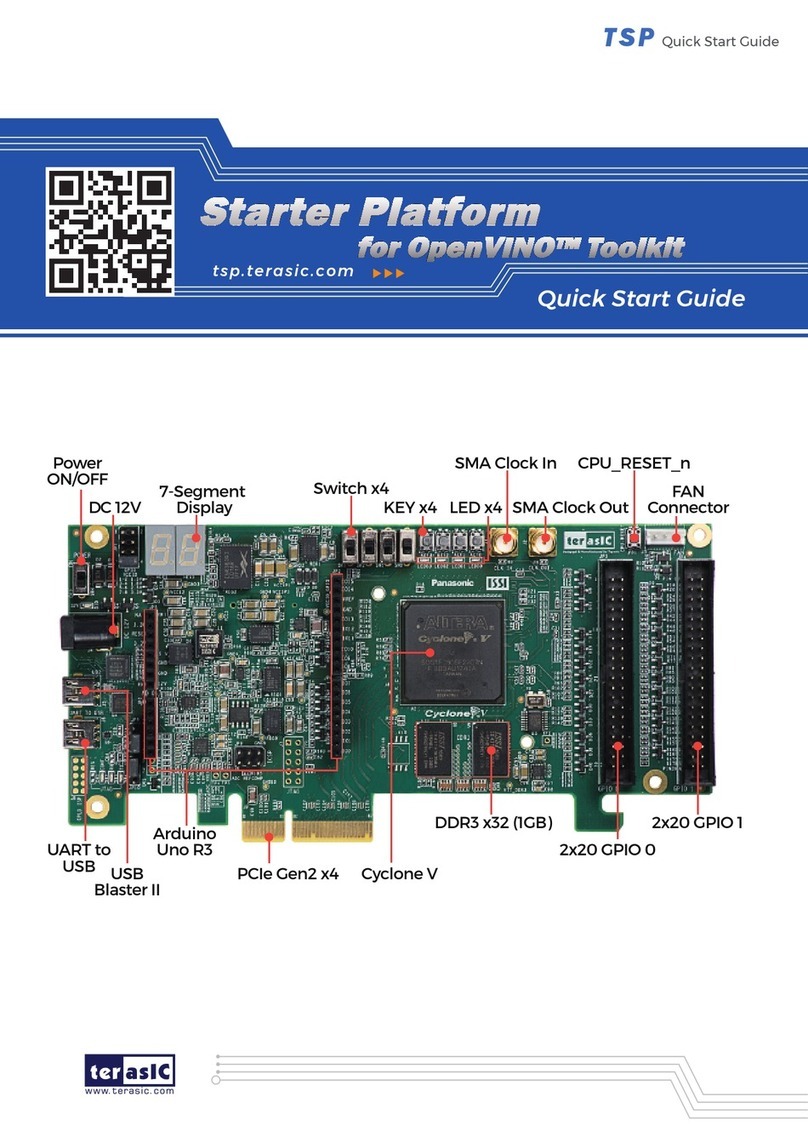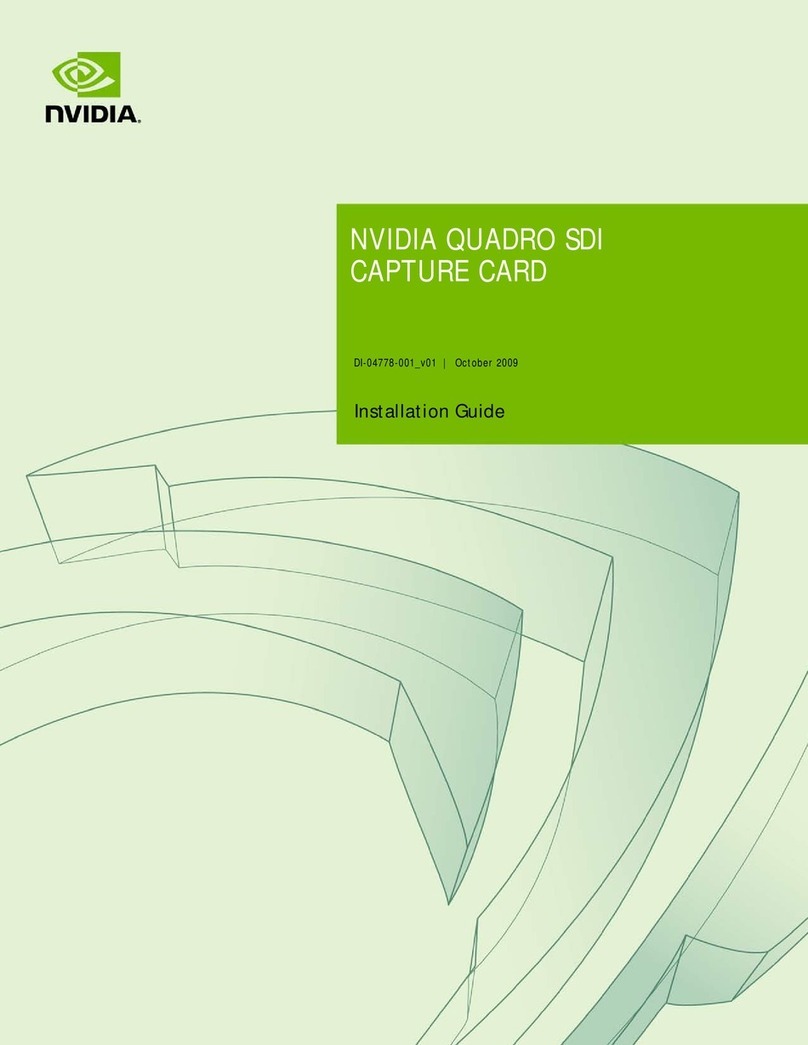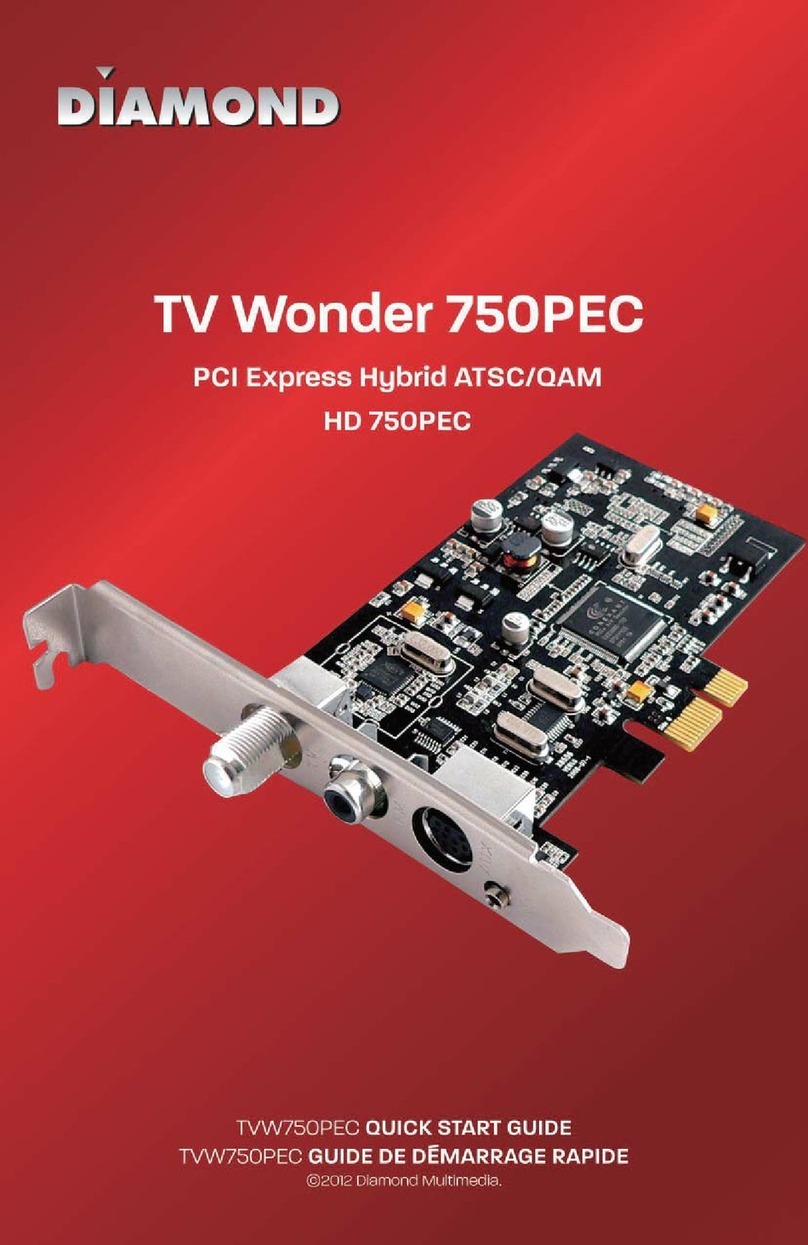Terasic THDB-SUM User manual

Terasic THDB-SUM
T
TT
THDB
HDBHDB
HDB-
--
-SUM
SUMSUM
SUM
Terasic HSMC to Santa Cruz Daughter Board
User Manual
Document Version 1.3 JULY. 29, 2009 by Terasic

Introduction
ii
Page Index
INTRODUCTION................................................................................................................................................................................. 1
1.1
F
EATURES
........................................................................................................................................................................... 1
1.2
G
ETTING
H
ELP
.................................................................................................................................................................... 2
ARCHITECTURE................................................................................................................................................................................ 3
2.1
L
AYOUTAND
C
OMPONETS
.................................................................................................................................................. 3
2.2
B
LOCK
D
IAGRAM
................................................................................................................................................................. 5
BOARD COMPONENTS................................................................................................................................................................... 6
3.1
T
HE
HSMC
C
ONNECTOR
................................................................................................................................................... 6
3.2
S
ANTA
C
RUZ
C
ONNECTOR
............................................................................................................................................... 10
3.3
USB
O
N
-T
HE
-G
O TRANSCEIVER
..................................................................................................................................... 14
3.4
M
ICTOR
C
ONNECTOR
....................................................................................................................................................... 16
3.5
SD
C
ARD
I
NTERFACE
....................................................................................................................................................... 18
3.6
SMA
C
ONNECTOR
............................................................................................................................................................ 19
3.7
I2C
S
ERIAL
EEPROM ..................................................................................................................................................... 20
3.8
P
OWER
S
UPPLY
................................................................................................................................................................ 21
DEMONSTRATION .......................................................................................................................................................................... 22
4.1
C
ONNECTING
THDB-SUM
B
OARD TO
C
YCLONE
III
S
TART
B
OARD
............................................................................... 22
APPENDIX......................................................................................................................................................................................... 24
5.1
R
EVISION
H
ISTORY
........................................................................................................................................................... 24
5.2
A
LWAYS
V
ISIT
THDB-SUM
W
EBPAGE FOR
N
EW
M
AIN BOARD
...................................................................................... 24

Introduction
1
1
11
1
Introduction
THDB-SUM (HSMC to Santa Cruz / USB / Mictor Daughter Board) is an adapter board to convert High Speed
Mezzanine Connector (HSMC) interface to Santa Cruz (SC), USB, Mictor, and SD Card interface. It allows
users to use these interface on a host board with a HSMC connector.
Because of limited I/O numbers of the HSMC interface, the SC interface and USB port have to share the same
I/O pins. Users can choose which interface to be enabled by jumper selection.
Finally, the source signals from the HSMC interface to the SC header on the THDB-SUM board will be passed
through level shifters to adjust the logic level difference between the HSMC and SC interface board.
1.1Features
Figure 1.1 shows the photo of the THDB-SUM board. The important features are listed below:
•One HSMC connector for interface conversion
•One Santa Cruz interface
•Adjustable logic levels between HSMC and SC interface signals
•One Hi-Speed USB On-The-Go transceiver
•One Mictor Connector
•One SMA Connector for external clock input
•One SD Card Socket
Figure 1.1. The THDB-SUM board

Introduction
2
1.2Getting Help
Here are some places to get help if you encounter any problem:
Email to support@terasic.com
Taiwan & China: +886-3-550-8800
Korea : +82-2-512-7661
Japan: +81-428-77-7000

Architecture
3
2
Architecture
This chapter describes the architecture of the THDB-SUM board including its PCB and block diagram.
2.1 Layout and Componets
The picture of the TDRB-SUM board is shown in Figure 2.1 and Figure 2.2. It depicts the layout of the board
and indicates the location of the connectors and key components.
Mictor Connector (J2)
SMA Connector (J6)
JTAG TDI/TDO
Loopback Header (JP0)
HSMC Logical Level
Configuration Header (JP3)
USB/SC Function Select
Header (JP1)
SC Connector Logical Level
Configuration Header (JP3)
Level Shifters (U7~U8)
USB Host/Peripheral Mode
Configuration Header(JP2)
Santa Cruz Connector (J5)
Santa Cruz Connector (J4)
Santa Cruz Connector (J3)
Level Shifters (U3~U6)
Bus Switch (U1~U2)
Mini USB AB type
receptacle connector (J8)
USB On-The-Go transceiver (U11)
EEPROM(U10)
Figure 2.1. The THDB-SUM PCB and component diagram

Architecture
4
SD Card Socket (J7)
HSMC Connector (J1)
Figure 2.2. The THDB-SUM Back side – HSMC connector view
The following components are provided on the THDB-SUM board :
•HSMC expansion connector (J1)
•Santa Cruz Headers(J3,J4,J5)
•Mictor connector (J2)
•SMA connector (J6)
•Hi-Speed USB On-The-Go transceiver (U11)
oFully compliant with Universal Serial Bus Specification Rev. 2.0
oSupplement to the USB 2.0 Specification Rev. 1.3
oSupplement UTMI+ Low Pin Interface (ULPI) Specification Rev. 1.1
•Mini USB AB type receptacle connector(J8)
•Logic level configuration headers (JP3,JP4)
•SD Card socket(J7)
•I2C serial EEPROM (U10)
•Level translator (U3~U9)
•Bus Switches (U1~U2)

Architecture
5
2.2 Block Diagram
Figure 2.3 shows the block diagram of the THDB-SUM board
HSMC
Connector
SD Card Interface
Mictor Connector Interface
External Clock Input
I2C Interface
SC Interface
THDB-SUM
USB Interface
USB
Transceiver
Mictor
Connector
Bus
Switch
Santa Cru
Connector
SD Card
Socket
SMA
Connector
Level
Shift
Level
Shift
I2C Serial
EEPROM
To
HSMC Interface
Host Board
Figure 2.3. The block diagram of the THDB-SUM board

Board Components
6
3
33
3
Board Components
This section will describe the detailed information of the components, connector interfaces, and the pin
mapping tables of the THDB-SUM board
3.1 The HSMC Connector
This section describes the HSMC connector on the THDB-SUM board
THDB-SUM board contains an Altera standard HSMC connector. All the other connector interfaces on the
THDB-SUM board are connected to the HSMC connector. Figure 3.1, Figure 3.2, and Figure 3.3 show the
pin-outs of the HSMC connector. Also, the JTAG interface of the HSMC connector is shown in the Figure 3.4. If
users don’t need to use the JTAG interface on the THDB-SUM board, please short the header JP0 to loopback
the TDI and TDO signals on the HSMC connector.

Board Components
7
NC
NC
NC
NC
NC
NC
NC
NC
NC
NC
NC
NC
NC
NC
HSMC_SCL
HSMC_TMS
HSMC_TDI
SD Wpn
NC
NC
6
8
10
12
14
16
18
20
22
24
26
28
30
32
34
36
38
40
2
4
NC
NC
NC
NC
NC
NC
NC
NC
NC
NC
NC
NC
NC
NC
HSMC_SDA
HSMC_TCK
HSMC_TDO
SD DAT1
NC
NC
5
7
9
11
13
15
17
19
21
23
25
27
29
31
33
35
37
39
1
3
Figure 3.1. The pin-outs of Bank 1 on the HSMC connector

Board Components
8
SD DAT3
SD DAT2
HSPROTO_RESET
HSPROTO_IO0
HSPROTO_IO1
HSPROTO_IO2
HSPROTO_IO3
HSPROTO_IO4
HSPROTO_IO5
HSPROTO_IO6
HSPROTO_IO7
HSPROTO_IO8
HSPROTO_IO9
HSPROTO_IO10
HSPROTO_IO11
HSPROTO_IO12
HSPROTO_IO13
HSPROTO_IO14
EXT_CLK
CLK2
42
44
46
48
50
52
54
56
58
60
62
64
66
68
70
72
74
76
78
80
82
84
86
88
90
92
94
96
98
100
SD_DAT0
SD_CLK
SD_CMD
HSPROTO_IO40
HSPROTO_IO29
HSPROTO_IO30
HSPROTO_IO31
HSPROTO_IO33
HSPROTO_IO32
HSPROTO_IO35
HSPROTO_IO34
HSPROTO_IO37
HSPROTO_IO36
HSPROTO_IO39
HSPROTO_IO38
HSPROTO_IO15
HSPROTO_IO16
HSPROTO_IO17
OSC
CLK1
41
43
45
47
49
51
53
55
57
59
61
63
65
67
69
71
73
75
77
79
81
83
85
87
89
91
93
95
97
99
Figure 3.2. The pin-outs of Bank 2 of the HSMC connector.

Board Components
9
MICTOR_D14
MICTOR_D15
12V
MICTOR_D16
MICTOR_D17
12V
MICTOR_D18
MICTOR_D19
12V
MICTOR_D20
MICTOR_D21
12V
MICTOR_D22
MICTOR_D23
12V
MICTOR_D24
HSPROTO_IO23
12V
HSPROTO_IO24
HSPROTO_IO25
12V
HSPROTO_IO26
HSPROTO_IO27
12V
HSPROTO_CARDSEL
HSPROTO_IO28
12V
MICTOR_CLK
DEV_SEL_R5 0
GND
102
104
106
108
110
112
114
116
118
120
122
124
126
128
130
132
134
136
138
140
142
144
146
148
150
152
154
156
158
160
MICTOR_D0
MICTOR_D1
VCC33
MICTOR_D4
MICTOR_D5
VCC33
MICTOR_D2
MICTOR_D3
VCC33
MICTOR_D6
MICTOR_D13
VCC33
MICTOR_D12
MICTOR_D11
VCC33
MICTOR_D10
MICTOR_D9
VCC33
MICTOR_D8
MICTOR_D7
VCC33
HSPROTO_IO18
HSPROTO_IO19
VCC33
HSPROTO_IO20
HSPROTO_IO21
VCC33
HSPROTO_IO22
TR_CLK
VCC33
101
103
105
107
109
111
113
115
117
119
121
123
125
127
129
131
133
135
137
139
141
143
145
147
149
151
153
155
157
159
Figure 3.3. The pin-outs of Bank 3 of the HSMC connector
JP0
Open : JTAG Chain
Close : JTAG Pass
NM:No Mount
HSMC_TDI R1
R2
R3
R4
0
0
0
0
21
HSMC_TDO
HSMC_TDI HSMC_TDI
MICTOR_TDI
MICTOR_TDO
NM
NM
Figure 3.4. The JTAG interface setting of the HSMC connector.

Board Components
10
3.2 Santa Cruz Connector
This section describes the Santa Cruz connector on the THDB-SUM board
The THDB-SUM board comes with Santa Cruz connectors (J3, J4 and J5) to connect to a daughter board with
Santa Cruz interface. On the THDB-SUM, the pin of SC connector not directly connects with HSMC connector.
Owing to the limitation of number of HSMC connector I/O pins, SC connector and USB transceiver share some
I/O pins together, Please refer to Figure 3.5, those I/O pass through a Bus Switch chip first and then connect with
HSMC connector. Therefore users can only choose one function between SC connector and USB transceiver.
Users can refer to Table3.1 and use JP2 to choose a function
In addition, from the Figure 3.6, there are several level shift chips between HSMC and SC. Theses level shift
chips convert the logic levels of the signals between the HSMC and Santa Cruz connectors according to the
configurations of the headers (JP3, JP4). With this feature, users can use different I/O standards between the
HSMC host board and SC interface daughter board. Table 3.2 and Table 3.3 list the configurations of the voltage
level of the HSPROTO_IO BUS and the PROTO_IO BUS, respectively.
BUS
Switches
(U1~U2)
Santa Cruz
Connectors
(J3~J5)
Level
Shifters
(U3~U8)
USB OTG
Transceiver
(U11)
HSPROTO_IO[14..0]
HSPROTO_IO[40..15]
SWPROTO_IO[14..0]
PROTO_IO[40..0]
HSPROTO_RESET
SWPROTO_RESET
16
USB_D[7..0]
USB_CS_n
USB_CLKOUT
USB_NXT
USB_STP
USB_DIR
USB_RESET_n
14
16
27
HSPROTO_CARDSEL PROTO_CARDSEL
43
PROTO_RESET
HSMC Connector (J1)
JP1
DEV_SEL Open : USB
Close : Santa Cruz
Figure 3.5. The I/O distribution of the HSMC, Santa Cruz, and USB transceiver interface.
Table 3.1 The configuration of the Enable function on bus switch chip
JP1 setting Enable Function
Open USB OTC Transceiver
Close Santa Cruz conenctor

Board Components
11
HSMC Connector (J1)
Level
Shifters
(U3~U8)
VCCA VCCB
JP3 JP4
Santa Cruz
Connectors
(J3~J5)
PROTO_IO[40..0]
PROTO_CARDSEL
43
PROTO_RESET
43
HSPROTO_IO[40..0]
HSPROTO_CARDSEL
HSPROTO_RESET
Open : 2.5V
Close : 3.3V Open : 3.3V
Close : 5V
Figure 3.6 The diagram of the logic level transform block
Table 3.2 The configuration of the logic level on the HSPROTO_IO
BUS
JP3 setting Logic level of the HSPROTO_IO BUS
Open 2.5V
Close 3.3V
Table 3.3 The configuration of the logic level on the PROTO_IO BUS
JP4 setting Logic level of the PROTO_IO BUS
Open 3.3V
Close 5V
Finally, Figure 3.5 shows the pin-outs of the Santa Cruz connector. Detailed pin mappings between J3, J4, and
J5 to the HSMC connector is listed in Table 3.4, Table 3.5, and Table 3.6, respectively.
Note:
Because of the characteristic of the level translators, the data rate of the HSPROTO_IO and PROTO_IO
bus should be under 100 Mbps.

Board Components
12
Figure 3.7 Santa Cruz connector pin-outs
Table 3.4 The pin assignments of the Santa Cruz connector J3
SC Pin Number
SC Signal Name HSMC Pin
Number HSMC Signal Name HSMC Pin Name
3 PROTO_IO40
49 HSPROTO_IO40 HSMC_TX_N0
4 PROTO_IO29
53 HSPROTO_IO29 HSMC_TX_P1
5 PROTO_IO30
55 HSPROTO_IO30 HSMC_TX_N1
6 PROTO_IO31
59 HSPROTO_IO31 HSMC_TX_P2
7 PROTO_IO32
65 HSPROTO_IO32 HSMC_TX_P3
8 PROTO_IO33
61 HSPROTO_IO33 HSMC_TX_N2
9 PROTO_IO34
71 HSPROTO_IO34 HSMC_TX_P4
10 PROTO_IO35
67 HSPROTO_IO35 HSMC_TX_N3
11 PROTO_IO36
77 HSPROTO_IO36 HSMC_TX_P5
12 PROTO_IO37
73 HSPROTO_IO37 HSMC_TX_N4
13 PROTO_IO38
83 HSPROTO_IO38 HSMC_TX_P6
14 PROTO_IO39
79 HSPROTO_IO39 HSMC_TX_N5
Table 3.5 The pin assignments of the Santa Cruz connector J4
SC Pin Number
SC Signal Name HSMC Pin
Number HSMC Signal Name HSMC Pin Name
9 OSC 95 OSC HSMC_CLKOUT_P1
11 CLK1 97 CLK1 HSMC_CLKOUT_N1
13 CLK2 98 CLK2 HSMC_CLKIN_N1

Board Components
13
Table 3.6 The pin assignments of the Santa Cruz connector J5
SC Pin Number
SC Signal Name HSMC Pin
Number HSMC Signal Name HSMC Pin Name
1 PROTO_RESET 48 HSPROTO_RESET HSMC_RX_P0
3 PROTO_IO0 50 HSPROTO_IO0 HSMC_RX_N0
4 PROTO_IO1 54 HSPROTO_IO1 HSMC_RX_P1
5 PROTO_IO2 56 HSPROTO_IO2 HSMC_RX_N1
6 PROTO_IO3 60 HSPROTO_IO3 HSMC_RX_P2
7 PROTO_IO4 62 HSPROTO_IO4 HSMC_RX_N2
8 PROTO_IO5 66 HSPROTO_IO5 HSMC_RX_P3
9 PROTO_IO6 68 HSPROTO_IO6 HSMC_RX_N3
10 PROTO_IO7 72 HSPROTO_IO7 HSMC_RX_P4
11 PROTO_IO8 74 HSPROTO_IO8 HSMC_RX_N4
12 PROTO_IO9 78 HSPROTO_IO9 HSMC_RX_P5
13 PROTO_IO10 80 HSPROTO_IO10 HSMC_RX_N5
14 PROTO_IO11 84 HSPROTO_IO11 HSMC_RX_P6
15 PROTO_IO12 86 HSPROTO_IO12 HSMC_RX_N6
16 PROTO_IO13 90 HSPROTO_IO13 HSMC_RX_P7
17 PROTO_IO14 92 HSPROTO_IO14 HSMC_RX_N7
18 PROTO_IO15 85 HSPROTO_IO15 HSMC_TX_N6
21 PROTO_IO16 89 HSPROTO_IO16 HSMC_TX_P7
23 PROTO_IO17 91 HSPROTO_IO17 HSMC_TX_N7
25 PROTO_IO18 143 HSPROTO_IO18 HSMC_TX_P15
27 PROTO_IO19 145 HSPROTO_IO19 HSMC_TX_N15
28 PROTO_IO20 149 HSPROTO_IO20 HSMC_TX_P16
29 PROTO_IO21 151 HSPROTO_IO21 HSMC_TX_N16
31 PROTO_IO22
155 HSPROTO_IO22
HSMC_CLKOUT_P2
32 PROTO_IO23
134 HSPROTO_IO23
HSMC_RX_N13
33 PROTO_IO24
138 HSPROTO_IO24
HSMC_RX_P14
35 PROTO_IO25
140 HSPROTO_IO25
HSMC_RX_N14
36 PROTO_IO26
144 HSPROTO_IO26
HSMC_RX_P15
37 PROTO_IO27
146 HSPROTO_IO27
HSMC_RX_N15
38 PROTO_CARDSEL
150 HSPROTO_CARDSEL
HSMC_RX_P16
39 PROTO_IO28
152 HSPROTO_IO28
HSMC_RX_N16

Board Components
14
3.3 USB On-The-Go transceiver
This section describes the USB On-The-Go transceiver on the THDB-SUM board
The THDB-SUM is equipped with a NXP ISP1504C USB On-The-Go transceiver (U11) and Mini USB AB type
receptacle connector (J8) to provide USB interface to the HSMC interface host board. The ISP1504 is a
Universal Serial Bus (USB) On-The-Go (OTG) transceiver that is fully compliant with Universal Serial Bus
Specification Rev. 2.0, On-The-Go Supplement to the USB 2.0 Specification Rev. 1.3 and UTMI+ Low Pin
Interface (ULPI) Specification Rev. 1.1.
The pervious section, Santa Cruz Connector, has mentioned that USB transceiver and Santa Cruz connector
share the I/Os which connect to HSMC connector, which means users can only choose o
ne function between
USB and Satan Cruz interface, If users would like to choose the function of USB transceiver, please turn on
JP2. For more detailed information about this transceiver, please refer to the datasheet which can be found in
the NXP’s website.
In addition, for OTG implementations, a 2-pin header named JP1 is connected with ID (identification) pin of
the USB OTG transceiver and micro-USB receptacle. As shown in Figure 3.8, The logic level of the ID pin on
the USB OTG transceiver can be configured to logic high or low via JP1. As defined in On-The-Go supplement
to the USB 2.0 specification Rev. 1.3, the ID pin dictates the initial role of the link. If ID is detected as HIGH,
the link must assume the role of a peripheral. If ID is detected as LOW, the link must assume a
host role. Table 3.7 shows the JP1 configuration setting for the ID.
Finally, the detailed pin mappings between the USB On-The-Go transceiver and the HSMC connector are
shown in Table3.8.
Table 3.7 The configuration of the ID pin
JP2 setting Host or peripheral role
Open Peripheral
Close Host

Board Components
15
NXP
ISP1504C
(U11)
DM
DP
ID
Jack-Mini- USB-AB
(J8)
JP2 Close = Host
Open = Peripheral
DATA[7..0]
CS
RESET
DIR
STP
NXT
XTAL1
USB_DIR
USB_STP
USB_NXT
XTAL1
USB _D[7..0]
USB_CS_n
USB_RESET_n
XTAL2 XTAL2
USB_CLKOUT CLOCK
26MHZ
X1
HSMC Connector
(J1)
VBUS
USB
Bus
Switch
(U1,U2)
HSPROTO_IO
JP1 Open
Figure 3.8 The block diagram of the USB OTG transceiver and HSMC connector
Table 3.8 The pin assignments of the USB OTG Transceiver U11
USB Pin
Number USB Signal Name HSMC Pin
Number HSMC Signal Name
HSMC Pin
Name
1 USB_D0 48 HSPROTO_RESET HSMC_RX_P0
17 USB_RESET_n 86 HSPROTO_IO12 HSMC_RX_N6
19 USB_DIR 84 HSPROTO_IO11 HSMC_RX_P6
20 USB_STP 80 HSPROTO_IO10 HSMC_RX_N5
21 USB_NXT 78 HSPROTO_IO9 HSMC_RX_P5
23 USB_D7 74 HSPROTO_IO8 HSMC_RX_N4
24 USB_D6 72 HSPROTO_IO7 HSMC_RX_P4
25 USB_D5 68 HSPROTO_IO6 HSMC_RX_N3
26 USB_D4 66 HSPROTO_IO5 HSMC_RX_P3
27 USB_CLKOUT 62 HSPROTO_IO4 HSMC_RX_N2
28 USB_D3 60 HSPROTO_IO3 HSMC_RX_P2
29 USB_CS_n 56 HSPROTO_IO2 HSMC_RX_N1
31 USB_D2 54 HSPROTO_IO1 HSMC_RX_P1
32 USB_D1 50 HSPROTO_IO0 HSMC_RX_N0

Board Components
16
3.4 Mictor Connector
This section describes how to use the Mictor connector on the THDB-SUM board
The Mictor connector (J2) can be used for logic analysis on the HSMC-interfaced host board by connecting an
external scope or a logic analyzer to it. Figure 3.9 shows the pin-outs of the Mictor connector. Table 3.9 shows
the detailed pin mappings between the Mictor connector and the HSMC connector.
Figure 3.9 Mictor connector pin-outs
Table 3.9 The pin assignments of the Mictor connector J2
Mictor
Connector
Pin Number
Mictor Connector
Signal Name
HSMC Pin
Number HSMC Signal Name
HSMC Pin Name
5 MICTOR_CLK 156 MICTOR_CLK HSMC_CLKIN_P2
6 TR_CLK 157 TR_CLK HSMC_CLKOUT_N2
7 MICTOR_D24 132 MICTOR_D24 HSMC_RX_P13
8 MICTOR_D13 121 MICTOR_D13 HSMC_TX_N11
9 MICTOR_D23 128 MICTOR_D23 HSMC_RX_N12
10 MICTOR_D12 125 MICTOR_D12 HSMC_TX_P12
13 MICTOR_D22 126 MICTOR_D22 HSMC_RX_P12
16 MICTOR_D11 127 MICTOR_D11 HSMC_TX_N12
18 MICTOR_D10 131 MICTOR_D10 HSMC_TX_P13
20 MICTOR_D9 133 MICTOR_D9 HSMC_TX_N13
22 MICTOR_D8 137 MICTOR_D8 HSMC_TX_P14
23 MICTOR_D21 122 MICTOR_D21 HSMC_RX_N11

Board Components
17
24 MICTOR_D7 139 MICTOR_D7 HSMC_TX_N14
25 MICTOR_D20 120 MICTOR_D20 HSMC_RX_P11
26 MICTOR_D6 119 MICTOR_D6 HSMC_TX_P11
27 MICTOR_D19 116 MICTOR_D19 HSMC_RX_N10
28 MICTOR_D5 109 MICTOR_D5 HSMC_TX_N9
29 MICTOR_D18 114 MICTOR_D18 HSMC_RX_P10
30 MICTOR_D4 107 MICTOR_D4 HSMC_TX_P9
31 MICTOR_D17 110 MICTOR_D17 HSMC_RX_N9
32 MICTOR_D3 115 MICTOR_D3 HSMC_TX_N10
33 MICTOR_D16 108 MICTOR_D16 HSMC_RX_P9
34 MICTOR_D2 113 MICTOR_D2 HSMC_TX_P10
35 MICTOR_D15 104 MICTOR_D15 HSMC_RX_N8
36 MICTOR_D1 103 MICTOR_D1 HSMC_TX_N8
37 MICTOR_D14 102 MICTOR_D14 HSMC_RX_P8
38 MICTOR_D0 101 MICTOR_D0 HSMC_TX_P8
11 MICTOR_TDO 37 HSMC_TDO HSMC_TDO
15 MICTOR_TCK 35 HSMC_TCK HSMC_TCK
17 MICTOR_TMS 36 HSMC_TMS HSMC_TMS
19 MICTOR_TDI 38 HSMC_TDI HSMC_TDI
To use this interface, user needs to configure the JTAG interface on the HSMC interface host board. For
example, the steps of controlling the Cyclone III start board using Mictor interface is shown below:
1. Connecting the THDB-SUM board to the Cyclone III Start Board.
2. Removing the jumpers of JP1 and JP2 of the Cyclone III Start Board to connect the JTAG interface
between Cyclone III FPGA and the THDB-SUM board.
3. Short the TDI and TDO pins of the JTAG connector(J4), as shown in Figure 3.10
4. Disable the built-in USB blaster by shorting JP8 on the Cyclone III Starter Board
The above FOUR steps will make a closed JTAG chain as shown in Figure 3.11

Board Components
18
J4 Short
Close JP8
With jumper
Short TDI and TDO
pin of the J4
Open JP1 nad JP2
Figure 3.10 The configuration of the Cyclone III start board for controlling the JTAG chain using the Mictor
connector
Cyclone III
JTAG_TDO
LF_TDO
ADG3304
CII_TDO
OPEN
LF_TDI
LF_TDO
HSMC
HSMC_TDO
HSMC_TDI
JP1
HSMC_TDI
HSMC_TDO
TDOTDI
J4
TDI
TDO
JP2
VCC25
MAX 3128
Built-in
Blaster
ADG3308
TDI
TDO
TDI
TDO
JP8
USB3V
Cyclone III Start BoardTHDB-SUM Board
SHORT
Mictor connector
J2
MICOTR_TDI
MICOTR_TDO
MICOTR_TDI
MICOTR_TDO
OPEN
CLOSE
Figure 3.11 The JTAG chain between the THDB-SUM board and Cyclone III Start Board
3.5 SD Card Interface
This section describes the SD Card Interface on the THDB-SUM board
The THDB-SUM has a SD card socket and can be accessed as optional external memory in both SPI and
1-bit SD mode. Table X shows the pinout of the SD card socket with HSMC connector. Figure 3.12 and Table
3.10 shows the pin connection and pin-out between the Mictor connector and HSMC connector, respectively.
This manual suits for next models
1
Table of contents
Other Terasic PCI Card manuals
Popular PCI Card manuals by other brands
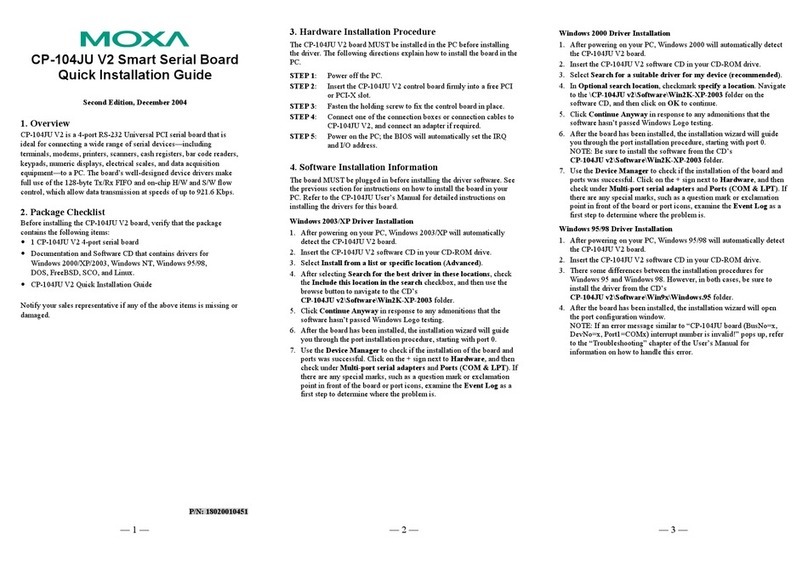
Moxa Technologies
Moxa Technologies CP-104JU V2 Quick installation guide
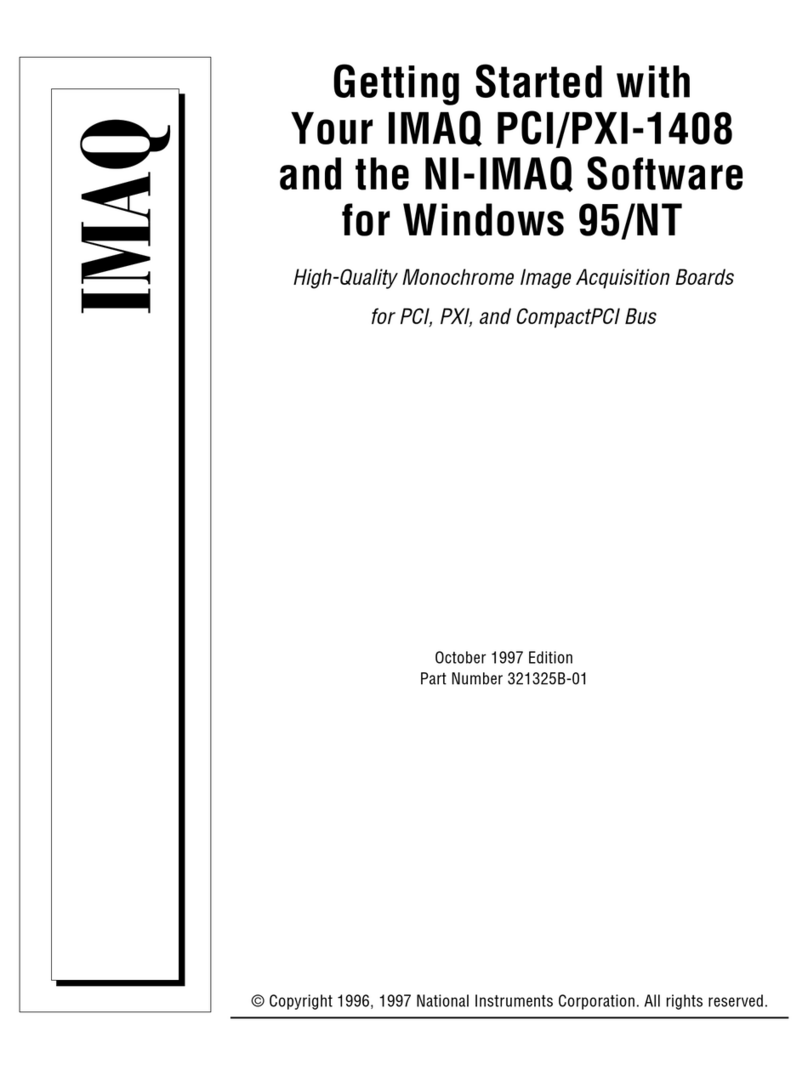
National Instruments Corporation
National Instruments Corporation IMAQ PCI-1408 Getting started
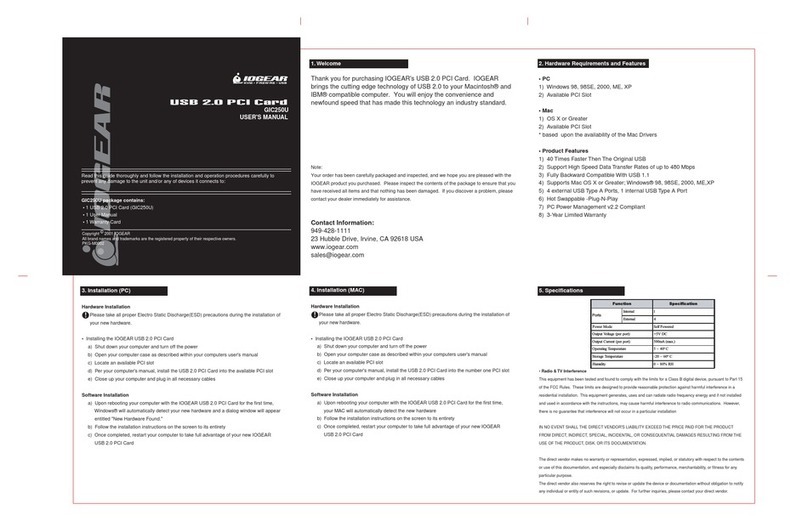
IOGear
IOGear GIC250U user manual
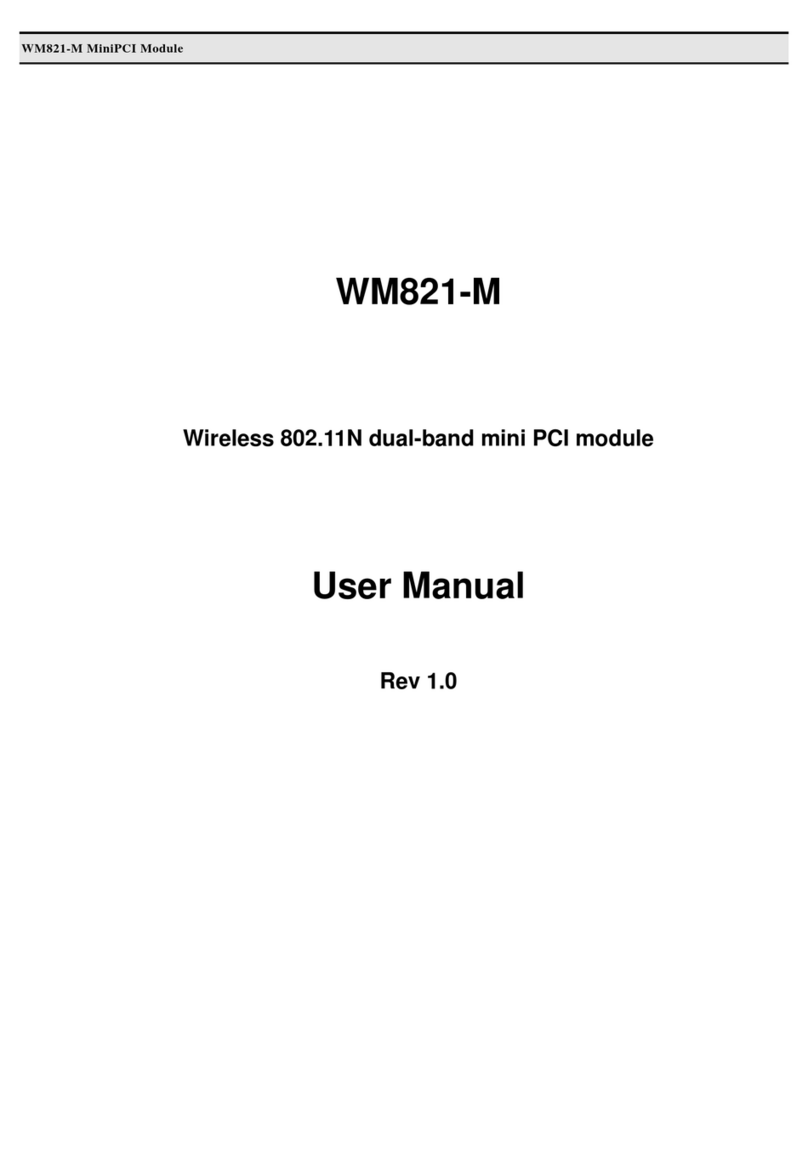
Linksys
Linksys WM821-M user manual

HOLT
HOLT ADK-6130PCIe user guide
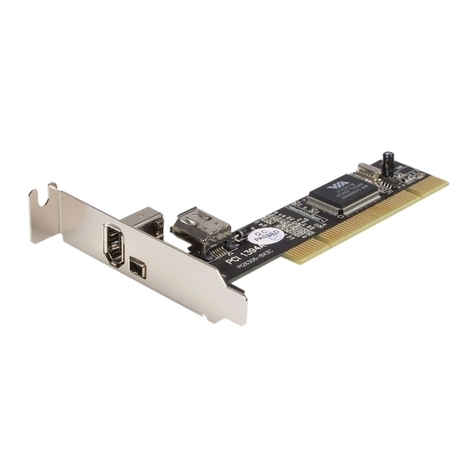
StarTech.com
StarTech.com PCI1394_2 instruction manual
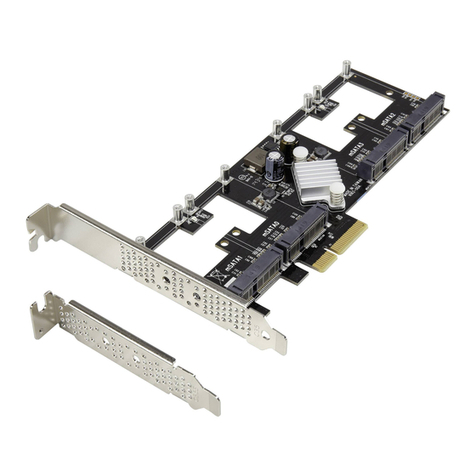
Conrad
Conrad 1000182 operating instructions
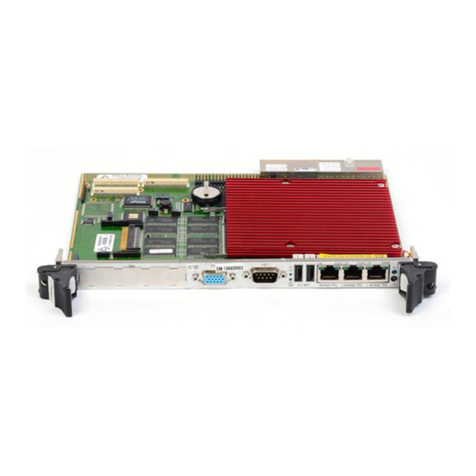
Kontron
Kontron CP605 manual
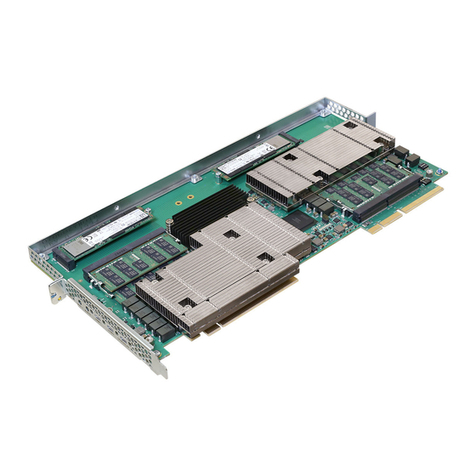
SMART Embedded Computing
SMART Embedded Computing PCIE-7217 Installation and use
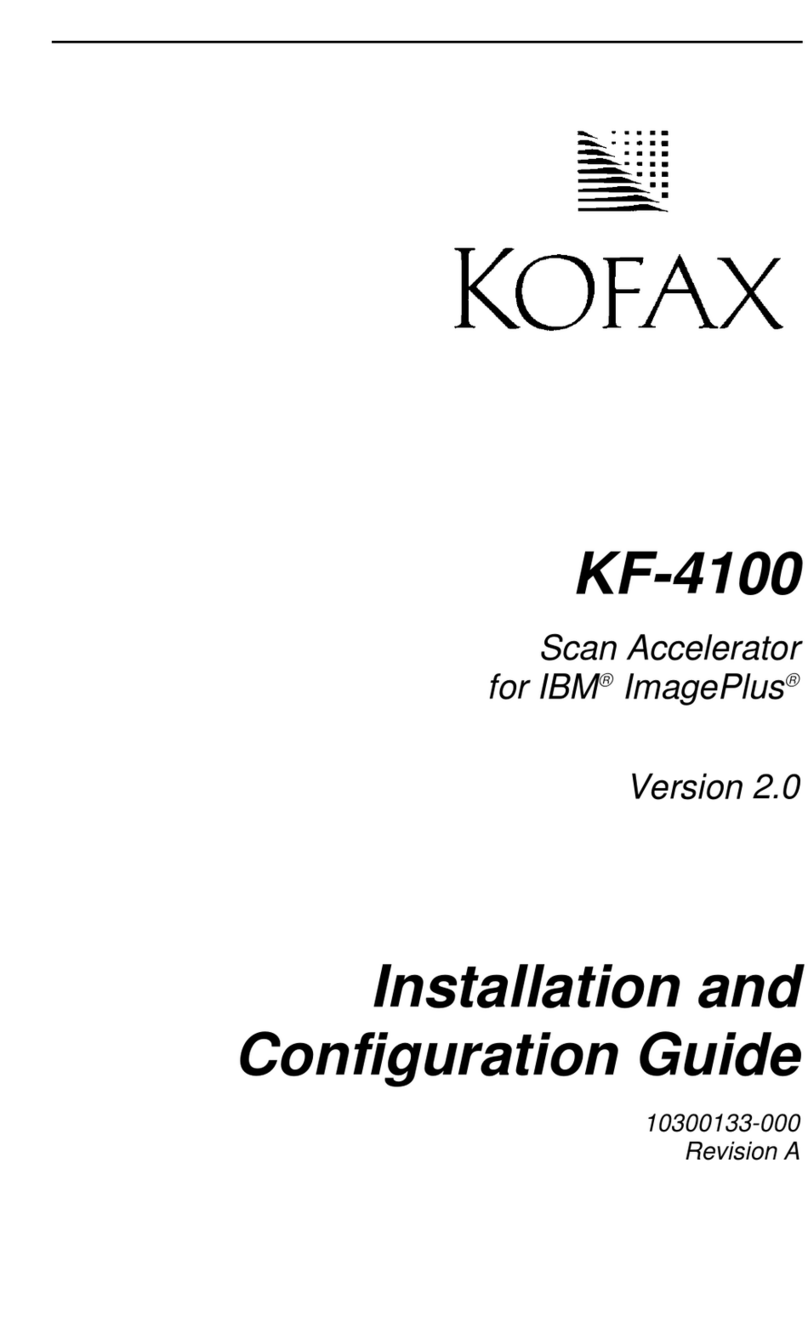
Kofax
Kofax KF-4100 Installation and configuration guide

Teltonika
Teltonika TMP-102 user manual
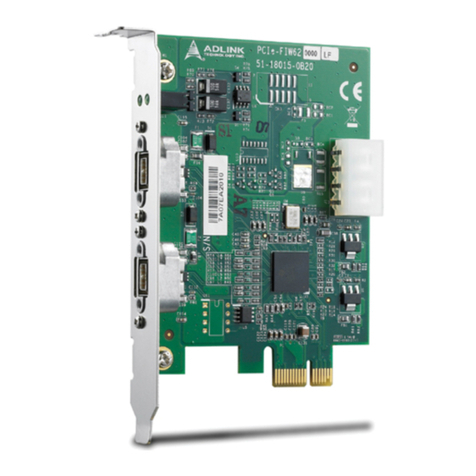
ADLINK Technology
ADLINK Technology PCIe-FIW Series user manual
